

If you’re looking to connect to the full force of nature, perhaps to feel the enormity of the pandemic shrink amongst ancient and seismic forces, head to Iceland, says Mark Stratton
This is a feature from Issue 6 of Charitable Traveller. Click to read more from this issue.
My skin prickles at the heat of an erupting volcano, glacial ice crunches beneath my crampons, I listen to the plaintive cries of curlews scything across windswept peninsulas and let hot spring minerals revitalise my body. The problem with Iceland though, is that when I describe it to friends I find myself lapsing into the sort of hyperbole more familiar in a tourist board brochure. True, Iceland invites superlatives but more than this, it offers a genuine reconnection with nature’s wildest forces.
If a North Atlantic latitude of 64°N fashions a glacial landscape, then it is the diverging tectonic plates pulling Iceland apart that lend geothermal showmanship. Something I am aware of on my latest trip shortly before landing at Keflavik Airport, when the pilot swoops low enough to get a better look at Fagradalsfjall – Iceland’s newest active volcano on the Reykjanes Peninsula. Perhaps not for the faint-hearted.
Nonetheless, we arrive safely, and I check into the Northern Lights Inn, one of my favourite accommodations on the peninsula. The inn nestles within a basalt lava plain where superheated steam hisses from cracks in the rock. It’s rather clichéd to compare such desolate fiery landscapes to Dante’s Inferno, yet I suspect that if the book’s hero had discovered Reykjanes on his descent to explore hell he might have pleaded with his guide Virgil to return to the surface.
Indeed, it’s all brimstone and fire during a first morning on the remarkable Reykjanes peninsula. At Seltún, I find soils tainted canary yellow, green, and ruby-red caused by emitting sulphur reacting with the ground’s minerals. The air has a gassy, eggy smell in a fantasy valley of bubbli
This is all courtesy of the diverging tectonic plates – something best witnessed nearby at Bruin milli Heimsalfa – the so named ‘Bridge of Continents’ near Sandvík, where a footbridge spans a shallow chasm marking the exact place where the North American and Eurasian tectonic plates pull apart at approximately 2cm a year. On one end of the bridge, I stand on the North American continent, but when I stroll across to the other side, I’m back in Europe.
Gateway to the Underworld
These, however, are hors d’oeuvres prior to the spectacle of Fagradalsfjall. All morning, I see a billowing mushroom-shaped plume on the horizon. It probably suggests ‘keep away’, but I’m drawn towards Iceland’s newest eruption like a moth to a flame. Emerging within a valley, Fagradalsfjall began to vent its spleen back on March 19th 2021 and, being accessible on foot and close to Keflavik Airport, it has quickly become Iceland’s must see attraction. I park up east of the town of Grindavik to begin an hour’s hike up a bare hillside currently acting as a buffer holding up the flow of Fagradalsfjall’s lava towards the sea.
Yet I’m far from alone ascending the trail. I’d been told that when Fagradalsfjall erupted locals were grilling sausages over the lava with long sticks. Now I see a group of school children on a geography field trip, and smile imagining what health-and-safety in the UK might have to say about this. Halfway up, a group of younger guys in flipflops are taking a breather, their portable stereo and crates of beer proving suddenly too heavy.
Something profound, however, unites us all. Reaching the top of a ridge, I look across a slow oozing tide of molten black basalt rock rippling with each surge of lava passing below it, veins of orange magma burning through the surface. The lava is fed from the new crater. Fagradalsfjall is growing every day.
As I climb warily down the hillside, keeping my eyes fixed on the Icelanders to be sure how close I can go, I hear a growling intensify from within the crater. It sounds like pebbles being centrifugally spun around the inside of a cement mixer. This is the cue for eruptions that occur every ten-minutes as regular as clockwork. Thereafter, the pyrotechnics commence with a river of lava gushing through the partly collapsed wall on one side of the jet-black crater. Utterly transfixed, I feel the heat of this magma outflow and I squint at an intense brightness you might associate with the formation of a new sun. Then comes the big bang. Propelled 400 to 500 metres skywards, vivid orange magma rises then dances in a series of peaks, almost suspended in slow motion, such is the viscosity. Around me I hear screams of excitement. I fire off hundreds of images of essentially the same view. Yet no photograph can capture the profundity of what I am witnessing – the origins of our Earth in formation.

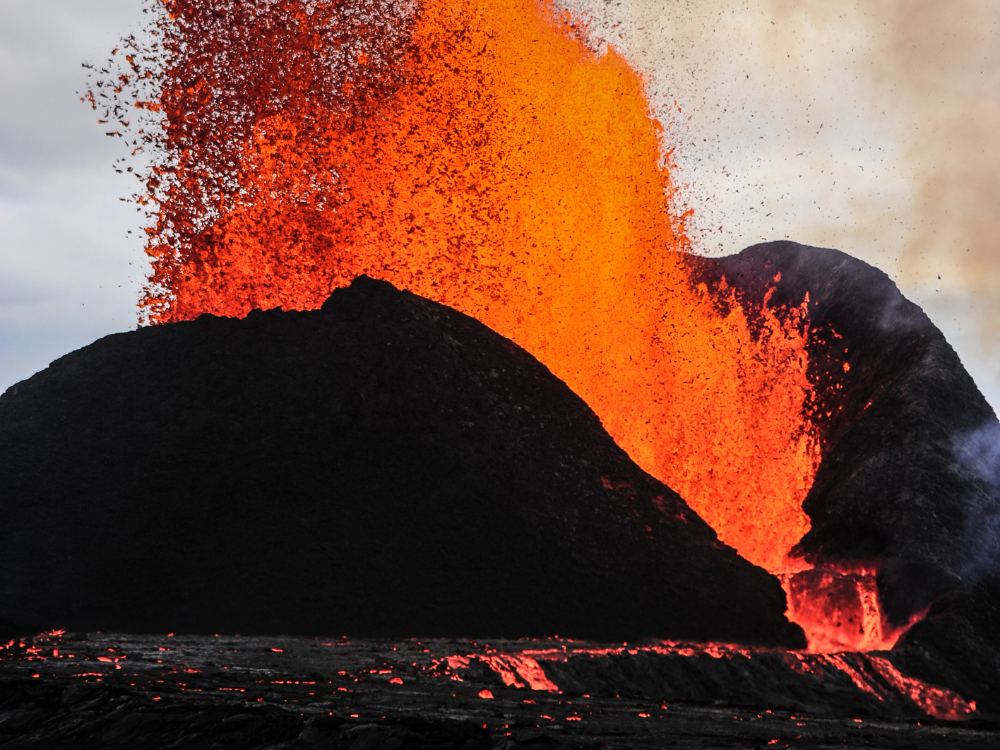
"Then comes the big bang. Propelled 400 to 500 metres skywards, vivid orange magma rises then dances in a series of peaks, almost suspended in slow motion"
Natural Highs
The geothermal wizardry of Reykjanes scarcely abates, when later I surrender to forces more conducive to my physical wellbeing. Not far from my hotel, I float in the powdery-blue heated water of the world-famous Blue Lagoon. It’s a good time to visit this popular attraction during the pandemic as visitor numbers to Iceland are down.
The algae and silica-rich waters of this outdoors geothermal pool are heated to 37-40ºC by the mixing of seawater and superheated freshwater two kilometres below the earth’s surface. The silica is said to treat skin complaints, like psoriasis. I scrape a handful of the squidgy silica mud and smear it into my face, hoping I might emerge looking like Brad Pitt. It’s 0ºc outside, and clear, and I bathe beneath a starry nebula. The forces of the earth and sky are aligned just like my own sense of wellbeing after a remarkable day.
Reinvigorated, it’s an early start, next morning. I head to Reykjavik for a couple of nights. I’ll be honest. It’s not my favourite city. But then perhaps busy urban life reminds me of what I am seeking to escape. Yet the main street, Laugavegur, with few restrictions at the time due to almost negligible coronavirus, imbues a sense of freedom from lockdown woes.
It’s also a base for a further opportunity to commune with climactic extremes, as I join a glacial hiking excursion to Iceland’s southern coast. By early summer Iceland’s lowland snow cover has melted away, uncloaking green pastureland. Gorging on that pasture are iconic Icelandic ponies – squat, broad of back, and possessing romantic, long flowing manes. Meanwhile rivers criss-cross the landscape, fed by glacial meltwater, sometimes via waterfalls careening over the cliffs of u-shaped valleys sculpted by the ebb-and-flow of past glaciations.
Ice on Fire
This meltwater, however, is symbolic of great adjustment for Iceland. The 11km-long Solheimajokull Glacier is in full retreat. Between 2017 and 2018 alone it retreated 100 metres. “It could be gone in a century’s time,” says Arnar Olaffson, taking me out for a hike with crampons.
On a surface whipped up like a meringue, I walk across an icescape striped like a zebra’s hide, as the blinding white ice is streaked with ridges of black ash. Historic eruptions had scattered the ash onto successive glacier surfaces that are now being revealed by melting. As we crunch our way across Solheimajokull (and crampons are easy to get used to, once you trust you will not fall face downwards wearing them) we trek through gullies of blue-tinged transparent ice and trace crevasse cracks gushing with icy melt water hurrying off the glacier beneath our feet. As I drive northwards out of Reykjavik later, I think about the balance I have witnessed of Fagraldsfjall replenishing the Earth and how, through anthropogenic impact, Iceland’s glacial landscape is in retreat.
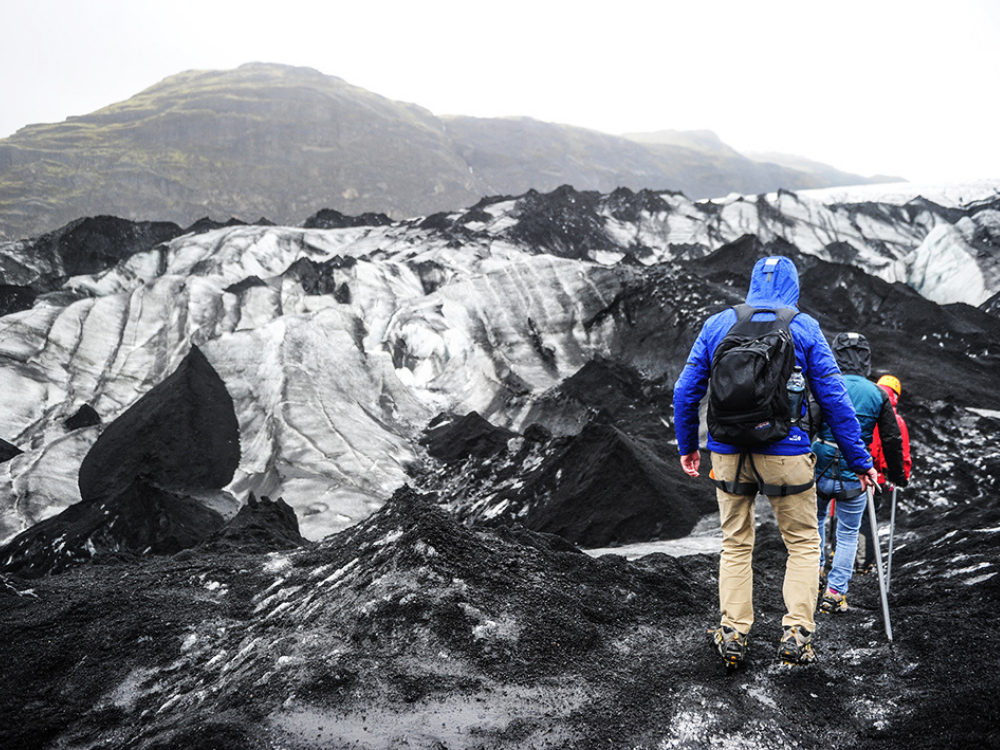
The same fate likely awaits the colossal Snæfellsjökul Glacier, which guides me like a beacon to a peninsula I adore. Snæfellsnes is a place of meditative retreat and unbridled nature. Looking at it on a map it’s shaped like a bratwurst sausage, jutting into the Atlantic Ocean. The 90km-long peninsula in northwest Iceland was formed by successive eruptions over 800,000 years from a strato volcano now covered by the glacier. Nordic mythology recalls a giant, Bárdur, dwelling above the volcano in an ice cave, to where he’d fled after killing his two nephews who slighted his daughter. There, according to legend, he resides for eternity.
I wasn’t planning a stay that long but with never-ending daylight during my five days in a self-catering cottage in Hellnar hamlet, my visit feels like a lifetime. I’m close to a coastline convoluted by seastacks and arches and throughout my stay I hardly see another living soul. My conversations are mostly with the curlews and plovers dipping and diving around my cottage. And when the maritime gusts rip across the peninsula and rattle the hinges of my door I imagine Bárdur on the prowl.
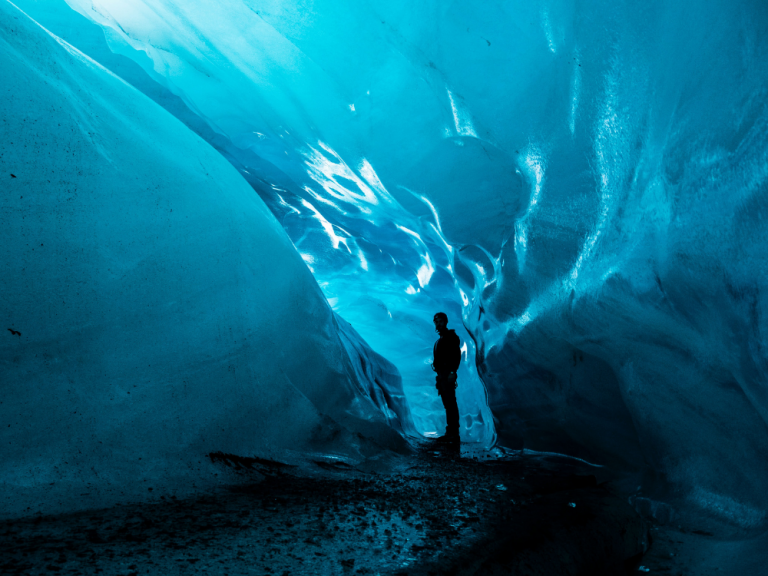
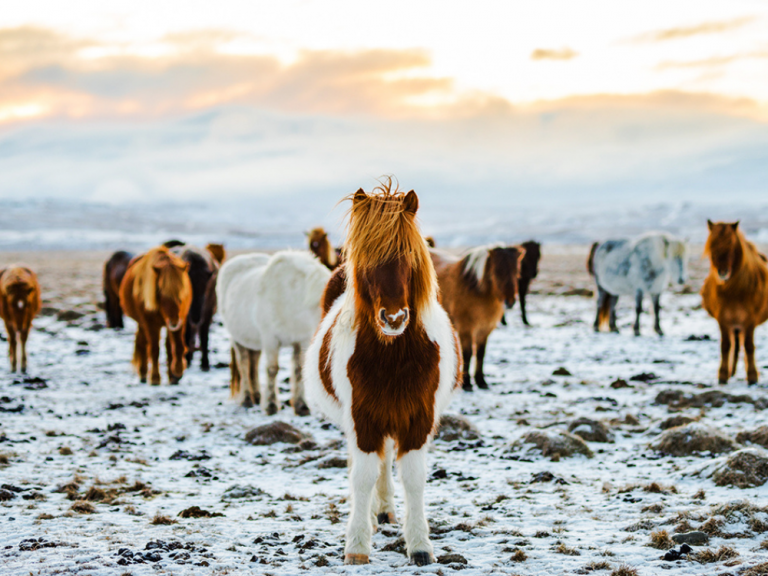
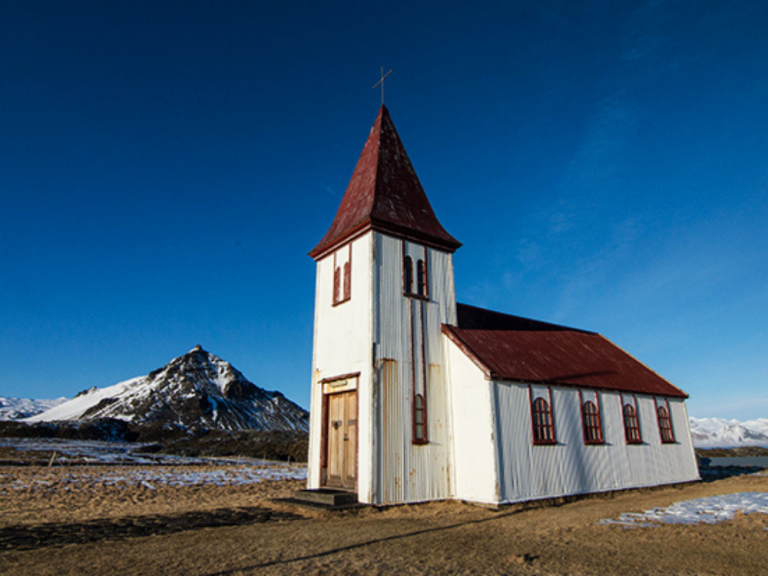
"Throughout my stay I hardly see another living soul. My conversations are mostly with the curlews and plovers dipping and diving around my cottage"
Going Wild
Yet this is a communion with nature to invigorate the soul. On hikes, I follow paths through causticlava plains along the coast to visit lonely lighthouses or simple wooden Lutheran churches. I watch arctic terns acrobatically dancing like sprites and walls of kittiwakes and guillemots defending precarious nests on cliff ledges above thunderous waves. I see stealthy arctic foxes causing consternation among them.
One lunchtime, I eat my sandwiches on the crater rim of the 112m-high Saxhóll. Like pimpled acne, a field of subsidiary cones have erupted over time but lie dormant, now covered in a soft blanket of purple wild thyme, crowberries, which are sweet to taste, and spongy sphagnum moss. But of all the places I find peace to sit and contemplate life, it’s Djúpalonssandur – without doubt the most beautiful beach I’ve ever seen. The ocean rakes the beach’s jetblack pebbles gleaming like opals up a tilted foreshore. The cliff behind is breaking away into pointed sea-stacks resembling witches’ Halloween hats, their forms inspiring local myths about nocturnal dwelling elves and trolls turned to stone when caught in daylight.
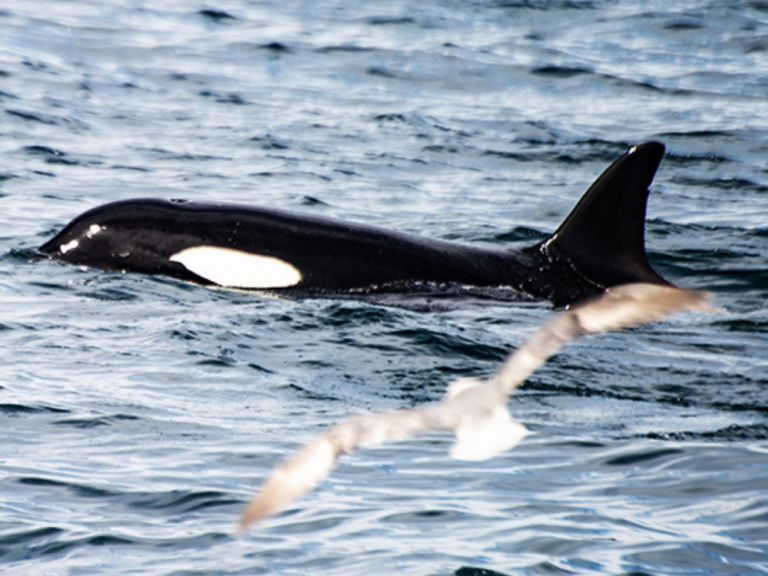
Chasing Freedom
Yet, with respect to Bárdur, only one resident of Snæfellsnes truly merits mythical status. To seek them out, I drive to the north of the peninsula to a fishing village called Ólafsvik, in the scalloped bay of Breidafjödur. A boat awaits, piloted by Captain Gisli. The sea is energetic. But I resolutely maintain my position on the front of his vessel, dashed by spray that doesn’t dampen my resolve to glimpse the ocean’s greatest predator– the orca.
Within half-an-hour the tall dorsal fins of the Snæfellsnes orca pod, which number around 600-700, I’m told by our onboard spotter, Karl, are all around the boat. They are chasing herring. We watch them hunting in teams, with a manoeuvrability and speed no human-made submersible could match. “They swim around and ball the herring together,” says Karl. “They are so sophisticated. They emit a high-frequency resonance that paralyses the herring’s swim bladder so that they cannot get away”.
We watch them for an hour. A bright afternoon light shimmering on their neopreneblack bodies, youngsters in tow of their mothers, like small dolphins, copying and learning. A scene likely repeated for millennia, long before the first Norse settlers arrived in the 9th-century to explore this striking island where natural beauty and reconnection with the primal forces of Mother Earth go hand-in-hand.
Adopt a Puffin
Iceland has the lion’s share of puffins but the UK is home to several colonies, including those on the Welsh islands of Skomer and Skokholm. Adopt a puffin to help protect them. welshwildlife.org
When Volcanoes Go Bad
Volcanoes are beautiful but potentially deadly. UNICEF provided assistance to almost 5,000 children affected by the eruption of St. Vincent & the Grenadines’ La Soufriere this year. unicef.org.uk
This is a feature from Issue 6 of Charitable Traveller. Click to read more from this issue.

















 by net effect
by net effect